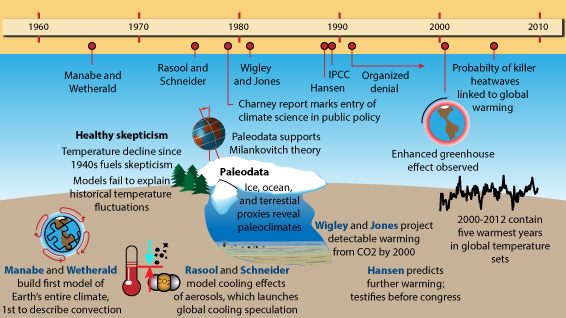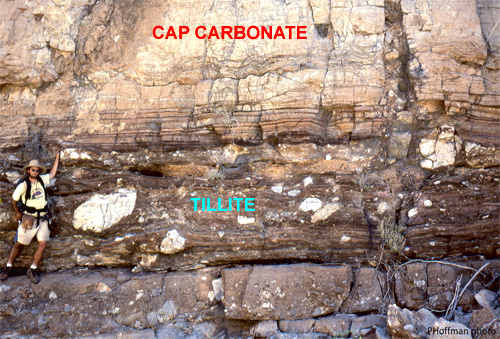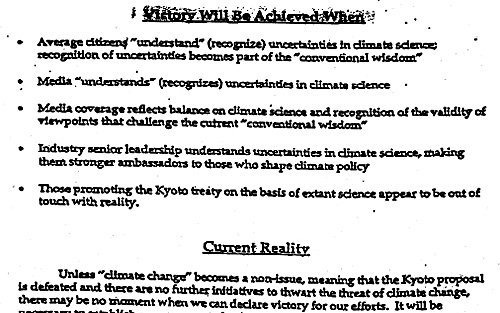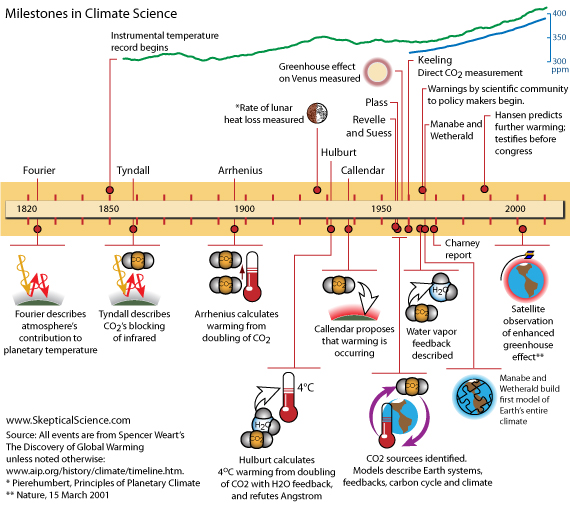Two Centuries of Climate Science: part three - Manabe to the present day, 1966-2012
Posted on 11 May 2012 by John Mason
The fact that carbon dioxide is a 'greenhouse gas' - a gas that prevents a certain amount of heat radiation escaping back to space and thus maintains a generally warm climate on Earth, goes back to an idea that was first conceived, though not specifically with respect to CO2, nearly 200 years ago. The three-part tale of how this important physical property, its role in the geological past and understanding how it may affect our future, covers about two centuries of enquiry, discovery, innovation and problem-solving.
This post is Part Three of this series, which also includes Part One and Part Two.

graphic: jg
We begin this third part of the narrative with a breakthrough. By 1967, the first computer model that simulated the entire planet's climate had been developed by Syukuro Manabe, working in collaboration with Richard Wetherald. It may have been relatively basic compared to modern models, but nevertheless they found that the movement of heat through convection kept the temperature from running away to extreme levels: however, if the amount of CO2 doubled, temperature would rise by some 2°C. Convective updraughts, such as those that can lead to thunderstorm development, transport a lot of heat from Earth's surface up towards the upper troposphere: a warming surface enhances the process, so that more and more heat is carried up and finds its way to levels where it may be re-radiated out into Space. If the surface got warmer, convection would carry more heat up. This important additional control addressed a long-standing problem that few workers, with the notable exception of Hulburt, had examined in depth.
Despite such advances, much doubt was still expressed in the scientific community: climatologist Helmut Landsberg commented in 1970 that the rise of CO2 at the then rate might bring a 2°C rise in temperature over the coming four centuries. This, he felt, could "hardly be called cataclysmic." It was also pointed out, by climatologist Hubert Lamb among others, that the uncertainties included a failure to explain previous temperture fluctuations, known from historical data, over the previous centuries. In addition, temperatures had declined a little since the 1940s yet carbon dioxide levels had increased. What was that about? S. Ichtiaque Rasool and Stephen Schneider of NASA, for example, modelled the effects of pollution in the form of aerosols and sulphur emissions in the atmosphere and discovered that a significant increase of such pollution could - possibly - lead to a cooling episode. Such findings even led to a small minority of scientists and a larger number of commentators musing over whether the current interglacial was coming to an end. Were we about to enter a new ice-age? The media loved that one: despite being a minority view, it was nice and dramatic, thereby making news headlines.
There was only one way to find out the answers as to what was really going on: continue the research effort. Through the 1970s and into the 1980s, more important developments occurred, these coincident from the mid-70s onwards with a resumption of warming. The identification of other, sometimes more powerful, greenhouse gases such as methane, the contributions to atmospheric carbon dioxide from other human activities such as deforestation and cement manufacture, better understanding of the temperature-changing properties of atmospheric pollution such as sulphur emissions, aerosols and their importance in the post-1940s northern hemisphere cooling: the knowledge-base was increasing year by year. It became understood that both plants and oceans had limits with respect to how much carbon dioxide they could take up over a fixed time. Computer models were steadily improving as the parameters became better understood. Writing in a 1981 paper in the journal Nature, climatologists Tom Wigley and Phil Jones said: "The effects of CO2 may not be detectable until around the turn of the century. By this time, atmospheric CO2 concentration will probably have become sufficiently high (and we will be committed to further increases) that a climatic change significantly larger than any which has occurred in the past century could be unavoidable."
The drilling of cores in the Greenland and Antarctic ice-caps had by now become an important branch of research into the climate of the past. The ice contains minute bubbles of prehistoric air trapped when it was formed, and once a reliable method had been developed by which to isolate and analyse that air (it is done in a vacuum), it was possible to get an idea of the composition of the atmosphere of the past, through ice-ages and interglacials. It was found that, during the frozen depths of the last ice-age, carbon dioxide levels were much lower, at less than two hundred parts per million. By the mid-1980s, the famous Vostock core had been drilled to a depth of 2km, representing 150,000 years of climate history, or a complete interglacial-glacial-interglacial cycle. Carbon dioxide fluctuations showed a remarkably consistent relationship with temperature.
Data from the ice-cores were also beginning to demonstrate another aspect of the role of greenhouse gases: feedbacks. Even if warming episodes were initiated by orbital changes, the warming itself would cause the release of greenhouse gases from sources including the oceans and melting permafrost. These additional greenhouse gases would then act as powerful amplifiers to the initial warming. The reverse could also occur with increased greenhouse gas drawdown facilitating a temperature decline back into an ice-age. But given that carbon dioxide levels were now substantially higher than anything in the past two millions of years, in either glacials or interglacials, it had become abundantly clear that the greenhouse effect was something we needed to take extremely seriously: even if the precise future increase in temperature was still an unknown quantity, with a fairly wide error-range, models indicated that for a doubling of carbon dioxide from pre-industrial levels, a rise of three degrees celsius as a global average was the most likely outcome.
Another area of research was the much longer-scale climate changes of the long-distant past. Once plate tectonics had been understood, it had become possible, using a whole raft of geological techniques, to retrace the wanderings of the continents back over hundreds of millions of years. These paleogeographical reconstructions demonstrated that, at certain periods in the past, often lasting for tens of millions of years, the distribution of flora and fauna in the fossil record showed that warmth-loving species had enjoyed a much greater latitudinal range than they do at the present day. The planet as a whole must have enjoyed a much warmer climate, with the poles especially warm compared to recent times. Now that the carbon dioxide-temperature relationship was becoming well-understood, attention was turned to these 'hothouse' periods of the past, and evidence began to accumulate that carbon dioxide levels had indeed been much higher at these times.
This finding also answered another geological problem: that of the so-called 'Faint Young Sun Paradox'. For a long time, astrophysicists had known that the Sun was a main-sequence star that had gradually brightened by about 10% per billion years, so that it was considerably dimmer long ago. Geologists knew of some fairly widespread glaciations in the past: there was an ice-age at the end of the Ordovician period, some 445 million years back and, going further back again, there were some huge, perhaps planet-wide glaciations in the Proterozoic eon. The latter events left behind distinctive rock-sequences typically consisting of tillites (ancient boulder-clay, now solid rock) representing ice-deposited debris, overlain with a depositional break by cap-carbonates, chemical sediments of marine origin deposited during interglacials following global sea-level rises. But generally, despite this fainter sun, the climate had, outside of these chilly glitches, been warm, warmer than it ought to have been.

above: the calling-card of an ancient ice-age - an outcrop in Namibia of an ancient (Proterozoic) tillite of glacial origin, overlain by a dolomitic "cap-carbonate" sequence of marine origin, deposited in warmer post-glacial conditions. Photo: P. Hoffman.
Understanding the carbon-cycle was key to explaining this: the realisation was that throughout geological time the levels of carbon dioxide and other non-condensing greenhouse-gases had exterted major controls on the planetary temperature. Carbon dioxide had sources and sinks but every now and then there were major upward or downward swings as unusually powerful sources or sinks dominated the picture. These disturbances were recorded in the strata. Major sources, such as episodes of exceptional volcanic activity, covered near-continental sized areas with lavas and tuffs, thus leaving their calling-cards behind for geologists to examine. Major sinks, likewise: for example, as continents collided, mountain-ranges were formed, making phenomenal amounts of rock debris available to weathering-agents, of which carbon dioxide dissolved in rainwater is one of the most important. These occasional disturbances resulted in warmer and cooler climatic episodes respectively. It was as if these non-condensing greenhouse-gases were acting as the planet's thermostat.
Reconstructions of past Hothouse climates had shown that temperatures had been around six degrees higher on average, and higher still in polar regions, with no polar ice-caps and a temperate to subtropical fauna and flora, as evidenced by the fossil record in these areas. But there was a very important difference between then and now: the rate of fluctuations in atmospheric carbon dioxide levels in the past appeared in many cases to have been at a snail's pace compared to recent increases - and today's levels continue to go up exponentially - faster and faster and faster. Furthermore, very rapid (over a few tens of thousands of years) environmental changes in the geological past were often accompanied by mass-extinctions due to conditions changing faster than ecosystems could adapt to them. It was amid such realisations of how badly things could go wrong that the Intergovernmental Panel on Climate Change was founded, in 1988.
By the start of the twenty-first century, the serious risks associated with the continued tinkering with the planet's thermostat had become all too apparent. They included a wide range of problems: severe and unprecedented droughts affecting agriculture in some areas and severely inflating global food prices and also making conditions more favourable for wildfires; in other areas, increases in extreme rainfall events leading to widespread inundation, destruction of crops, casualties and property loss/damage. Sea level rise over the decades would again affect agriculture due to loss of fertile low-lying lands and would also lead to population displacement and mass-migration. Mankind was, in essence, busily engaged with making areas of the planet's surface uninhabitable for future generations.
It also needs to be recorded in passing that the 1990s saw the emergence of well-funded politically-based bodies promoting opposition to climate science, one of the first being the so-called Information Council on the Environment in 1991; by the closing years of the decade there was also the American Petroleum Institute with its 1998 "Global Climate Science Communication Action Plan", an excerpt from which may be seen below (screengrab of a PDF copy available from the climatesciencewatch.org website). This was a campaign aimed primarily in response to the Kyoto Protocol on limiting emissions, signed in December 1997.

The political trench-warfare that has ensued since that time will be familiar to most readers and the more recent climate science of the latest 20th and early 21st centuries has been extensively covered both here at Skeptical Science and at sites such as Realclimate. The basic principles remain the same, but everywhere the details are being fine-tuned as better methods of data-collection are developed, various problems with proxies that are used to understand the temperatures of the geological past are ironed-out and monitoring is improved. But Fourier, Tyndall and Arrhenius were definitely somewhere along the right track, all those years ago, when their pioneering work commenced into finding out what makes the Earth's climate tick. That's certainly something to recall if you're discussing climate change with somebody and they try to tell you that climate science has only been around for a couple of decades!

graphic: jg
Further Reading
Spencer Weart's The Discovery of Global Warming gives a very detailed account of the history of climate science with a plethora of references - there are many days' worth of in-depth study there for those who want to go beyond the blogosphere!































 Arguments
Arguments































[DB] Please note that posting comments here at SkS is a privilege, not a right. This privilege can and will be rescinded if the posting individual continues to treat adherence to the Comments Policy as optional, rather than the mandatory condition of participating in this online forum.
Moderating this site is a tiresome chore, particularly when commentators repeatedly submit offensive or off-topic posts. We really appreciate people's cooperation in abiding by the Comments Policy, which is largely responsible for the quality of this site.
Finally, please understand that moderation policies are not open for discussion. If you find yourself incapable of abiding by these common set of rules that everyone else observes, then a change of venues is in the offing.
Please take the time to review the policy and ensure future comments are in full compliance with it. Thanks for your understanding and compliance in this matter.
Inflammatory and off-topic snipped.